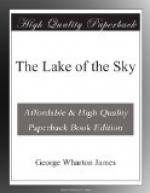Digger Pine. This is seldom found in the Tahoe region, except in the lower reaches of the canyons on the west side of the range. It is sometimes known as the Nut Pine, for it bears a nut of which the natives are very fond. It has two cone forms, one in which the spurs point straight down, the other in which they are more or less curved at the tip. They grow to a height of forty to fifty and occasionally ninety feet high; with open crown and thin gray foliage.
Western Juniper. This is a typical tree of the arid regions east of the Sierra, yet it is to be found scattered throughout the Tahoe country, generally at an elevation between five thousand and eight thousand feet. It ranges in height from ten to twenty-five or even sixty-five feet. Its dull red bark, which shreds or flakes easily, its berries, which begin a green color, shade through to gray, and when ripe are a rich purple, make it readily discernible. It is a characteristic feature of the scenery at timber line in many Tahoe landscapes.
With the crowns beaten by storms into irregular shapes, often dead on one side but flourishing on the other, the tops usually dismantled and the trunks excessively thickened at base, such figures, whether erect, half overthrown or wholly crouching, are the most picturesque of mountain trees and are frequently of very great age.—Jepson.
Yew. This is not often found and then only in the west canyons above the main range. It is a small and insignificant tree, rarely exceeding forty feet in height. It has a thin red-brown smooth bark which becomes shreddy as it flakes off in thin and rather small pieces. The seeds are borne on the under side of the sprays and when mature set in a fleshy scarlet cup, the whole looking like a brilliantly colored berry five or six inches long. They ripen in July or August.
Incense Cedar. This is commonly found all over the region at elevations below 7500 feet, though its chief habitat is at elevations of 3500 to 6000 feet. It grows to a height of fifty to one hundred and fifty feet, with a strongly conical trunk, very thick at the base, and gradually diminishing in size upward. The bark is thick, red-brown, loose and fibrous, and when the tree is old, broken into prominent heavy longitudinal furrows. The cones are red-brown, oblong-ovate when closed, three-fourths to an inch long.
Shasta Fir. This is found on the summits, slopes and shores of Lake Tahoe, and to levels 6200 feet in elevation on the slopes and summits directly connected with the main range. It is found along the Mount Pluto ridge. It is essentially a tree of the mountains, where the annual precipitation ranges from fifty inches upward. In the Tahoe region it is locally known as the red fir. Sometimes it is called the red bark fir and golden fir. It grows from sixty to even one hundred and seventy-five feet high with trunk one to five feet in diameter and a narrowly cone-shaped crown composed of numerous horizontal strata of fan-shaped sprays. The bark on young trees is whitish or silvery, on old trunks dark red, very deeply and roughly fissured. The cones when young are of a beautiful dull purple, when mature becoming brown.




